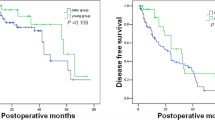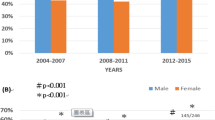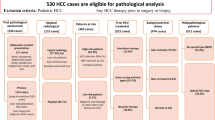Abstract
To investigate the clinicopathologic characteristics of primary liver cancer (PLC) in young adults, 77 patients aged 35 or younger were compared with 603 patients older than 35 years during the same period. In the young patients, PLC showed: (1) a low incidence detected at mass survey (young 15.6% vs older 28.7%,P<0.05); (2) a low level of history of hepatitis (young 36.8% vs older 66.3%,P<0.01); (3) a high incidence of positivity for hepatitis B surface antigen (HBsAg) (young 79.2% vs older 67.6%,P<0.05); (4) a relatively low incidence of associated cirrhosis (young 64.9% vs older 90.7%,P<0.01); (5) larger tumor size (PLC>5 cm; young 87.0% vs older 73.0%,P<0.01); and (6) a more advanced stage of the disease according to the TNM classification (stage III; young 29.9% vs older 18.2%,P<0.05). It is suggested that hepatitis B virus (HBV) may play an important role in the development of PLC without associated liver cirrhosis in young patients. Close periodic surveillance of young adults who are positive for HBsAg is important to detect PLC at an early stage.
Similar content being viewed by others
References
Zhou XD. Advances in primary liver cancer research (editorial comments). Chin J Cancer Res 1994;6:1–2.
Yu SZ. Epidemiology of primary liver cancer. In: Tang ZY (ed) Subclinical hepatocellular carcinoma. Beijing: China Academic Publishers, and Berlin Heidelberg New York: Springer, 1985; 189–210.
The Liver Cancer Study Group of Japan. Primary liver cancer in Japan, clinicopathologic features and results of surgical treatment. Ann Surg 1990;211:277–287.
Orlowski M, Szewczuk A. Determination of r-glutamyl transpeptidase activity in human serum and urine. Clin Chim Acta 1962;7:755–760.
Edmondson HA. Tumor of the liver and intrahepatic bile ducts. Washington DC: Armed Forces Institute of Pathology, 1958; 32–105.
Hermanek P, Sobin LH, for the International Union Against Cancer (UICC). TNM Classification of malignant tumors. 4th Ed. Berlin Heidelberg New York: Springer, 1987;53–55.
Munoz N, Bosch X. Epidemiology of hepatocellular carcinoma. In: Okuda K, Ishak KG (eds) Neoplasma of the liver. Tokyo Berlin Heidelberg New York: Springer, 1987;3–19.
Furuta T, Kanematsu T, Matsumata T, et al. Clinicopathologic features of hepatocellular carcinoma in young patients. Cancer 1990;66:2395–2398.
Zhou XD, Tang ZY. Factors influencing resectability and resection survival rates of subclinical hepatocellular carcinoma. In: Tang ZY (ed). Subclinical hepatocellular carcinoma. Beijing: China Academic Publishers and Berlin Heidelberg New York: Springer, 1985;78–84.
Author information
Authors and Affiliations
Rights and permissions
About this article
Cite this article
Zhou, XD., Tang, ZY., Yu, YQ. et al. Characteristics and prognosis of primary liver cancer in young patients in China. J Gastroenterol 30, 632–635 (1995). https://doi.org/10.1007/BF02367790
Received:
Accepted:
Issue Date:
DOI: https://doi.org/10.1007/BF02367790




